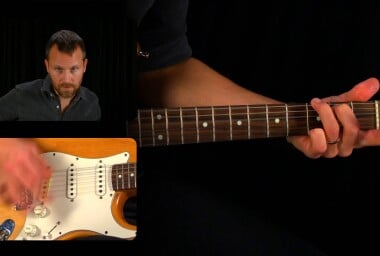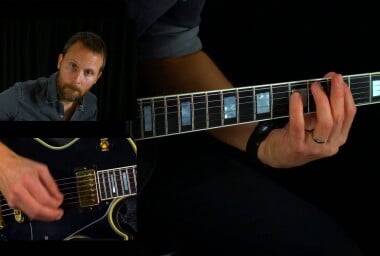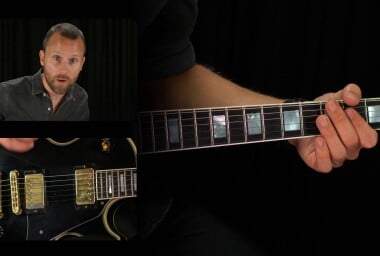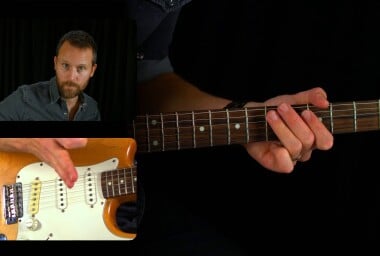Famous Riffs
-
 Famous Riffs: About A Girl
Famous Riffs: About A Girl"About A Girl" is a prime example of how some of the greatest riffs can be made up of the simplest components! Let me show you how to strum the intro and verse progression for this song. We are in the key of E minor for this song, and we'll be alternating between our open E minor chord and our G major chord, 2 beats on each....
Published: 12/23/2019 Upgrade -
 Famous Riffs: Back In Black
Famous Riffs: Back In Black"Back In Black" is another example of a brilliant rock'n roll riff that uses a creative combination rhythmic chords and bluesy single note lines to make you instantly wanna headbang. So before you do anything else, let me show you how to play just that riff. We'll be using three chords for this riff, which is E5 (just the thr...
Published: 11/17/2019 Upgrade -
 Famous Riffs: Bad Moon Rising
Famous Riffs: Bad Moon Rising"Bad Moon Rising" is an absolute classic and the guitar parts in it are a ton of fun to play. Let me show you how to play the instantly recognizable intro and verse part. The album version of this song is in the key of D, and the whole guitar is tuned down a whole step. That means we're playing an E major shape, but since ev...
Published: 12/30/2019 Upgrade -
 Famous Riffs: Folsom Prison Blues
Famous Riffs: Folsom Prison Blues"Folsom Prison Blues" features one of the most iconic intro riffs of all time and a classic strumming part that's a ton of fun to play. Let me show you how to play the intro riff leading into the acoustic verse part. We're in the key of E and we'll be playing in the open position. The intro lick is played by the electric lea...
Published: 12/11/2019 Upgrade -
 Famous Riffs: Hey Joe
Famous Riffs: Hey Joe"Hey Joe" is one of the most classic guitar songs of all time, jam packed with super cool guitar parts! Let me show you how to play the basic verse progression and all the signature rhythm embellishments used to create this iconic rhythm part. We're in the key of E and our basic progression for the verse goes C to G, half a...
Published: 12/23/2019 Upgrade -
 Famous Riffs: Let It Be
Famous Riffs: Let It Be"Let it Be" is arguably one of the greatest songs every written, and the piano part that drives the arrangement works really well on guitar as well, electric or acoustic! This song is in the key of C major and our basic progression of the intro and verse goes C G Am Fmaj7. For the second half it goes C G and then Fmaj7 to C....
Published: 12/11/2019 Upgrade -
 Famous Riffs: My Sharona
Famous Riffs: My Sharona"My Sharona" features a ton of cool guitar playing which every rock guitar player should spend some quality time with. So let me show you how to play the intro riff. We're in the key of G minor and we're working out of our old familiar pattern of the G minor pentatonic scale starting here in the 3rd fret. For the riff we'll...
Published: 01/30/2020 Upgrade -
 Famous Riffs: Runaway Train
Famous Riffs: Runaway TrainWhen you hear the song title "Runaway Train" you can almost hear the song in your head right away. Let me show you how to play the basic progression and acoustic strumming part for the verses of this great song. We're in the key of C and our basic harmony will be C for 2 bars. then we do a somewhat strange C major 7 chord, w...
Published: 12/30/2019 Upgrade -
 Famous Riffs: You Shook Me All Night Long
Famous Riffs: You Shook Me All Night Long"You Shook Me All Night Long" features one of the most recognizable rock'n roll riffs of all time. It's built up from some very simple chords, but with a catchy rhythm and quick changing between the chords it becomes absolutely stadium worthy, when you put it all together. So I have my regular electric guitar with a basic di...
Published: 11/17/2019 Upgrade -
 Famous Riffs: Cocaine
Famous Riffs: CocaineThe song "Cocaine" features one of the simplest and yet most recognizable riffs in rock 'n' roll. So let me show you how to play that riff which is also used for the verses. We're in the key of E and we'll be using our barre-chord with the root in the 7th fret of the A-string. Strum that with two downstrokes, “1 and...â€...
Published: 01/23/2020 Upgrade -
 Famous Riffs: Highway To Hell
Famous Riffs: Highway To Hell"Highway To Hell" is one of those songs that you recognize from within the first 3 notes of the guitar riff. This riff is made up of some fairly simple chords with a catchy rhythm and yet somehow it feels larger than life. Before we do anything else, let me show you how to play just the intro riff. We'll be using just three b...
Published: 11/03/2019 Upgrade -
 Famous Riffs: Kiss From A Rose
Famous Riffs: Kiss From A Rose"Kiss From A Rose" has one of the most recognizable chord progressions, constantly alternating between chords from the minor and major tonality, which is a really powerful songwriting tool that you can use too. Let me show you how to play the verse progression and strumming This song is in the key of G and we'll go through...
Published: 01/23/2020 Upgrade -
 Famous Riffs: Smoke On The Water
Famous Riffs: Smoke On The Water"Smoke On The Water" features one of the greatest rock 'n' roll riffs of all time! It's not complicated, but it is extremely powerful. So let me show you how to play it. We're in the key of G, and we'll be using these really cool double stops that almost end up sounding like an organ. The first one is on the A and D string i...
Published: 01/23/2020 Upgrade















